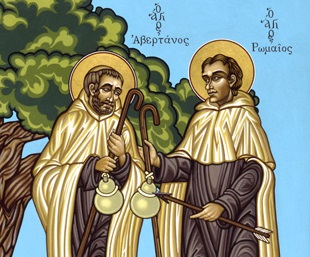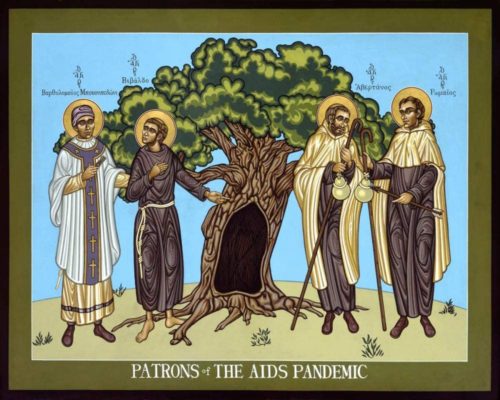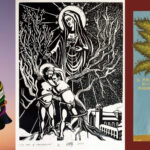Last Updated on February 25, 2024 by Kittredge Cherry

Saint Avertanus and Blessed Romeo are 14th-century French monks, traveling companions and “patrons of the AIDS pandemic” who died together of the plague and share the same coffin. They can also provide inspiration during other public health emergencies, such as the COVID-19 pandemic. Their feast day is Feb. 25.
The pair was revered and celebrated in the centuries after their deaths — so much that some say Blessed Romeo’s name is origin of the famous lover in Shakespeare’s play “Romeo and Juliet.”
Saint Avertanus of Limoges was born in Limoges, France. His name is Avertin in French and Avertano in Italian and Spanish. He entered the Carmelite order over the objections of his elderly parents and became a lay brother. He felt inspired to make a pilgrimage to Rome and onward to the Holy Land. So he got permission from his superiors at the cloister to make the pilgrimage.
His traveling companion was Blessed Romeo, also called Romaeus of Limoges. They faced rain and snow as they made the adventurous pilgrimage over the Alps from France to Italy, performing miracles along the way.
“They were two angels keeping company on the road,” according to “The Lives of the Saints” by Omer Engelbert.
When the couple reached Italy, every city was closed to travelers because of an epidemic of plague. Both friends contracted the disease. Avertanus was admitted to a hospital outside the city walls of Lucca, where Romeo ministered to him. Avertanus died there on Feb. 25, followed by Romeo on March 4.
The tale of their travels and miracles became enormously popular. Stories of their pious exploits grew increasingly elaborate in the decades following their deaths.
Their relics are still honored today in the same sarcophagus at the Church of Saints Paolino and Donato in Lucca. The marble tomb is attributed to early Renaissance sculptor Matteo Civitali, a native of Lucca.
An inscription on the sarcophagus says that “the two bodies were placed together so that these who dwell in the same house in heaven may be united in the honor of one same urn,” according to a Carmelite biography by Louis Saggi.
Most sources say that Avertanus died on Feb. 25, 1380, although Saggi provides evidence that their deaths were actually in the 13th century.
Avertanus and Romeo appear in AIDS icon
Avertanus and Romeo appear together in the icon “Patrons of the AIDS Pandemic” by Lewis Williams. It show two pairs of medieval male saints who faced disease epidemics together with friendship and faith. Their man-to-man bonds speak to the gay community, where AIDS has a disproportionately large impact.
Avertanus and Romeo carry the type of staff and water gourds used by pilgrims. Romeo holds an arrow, symbol of the plague.

Patrons of the AIDS Pandemic by Lewis Williams, SFO. Prints available from www.trinitystores.com and Amazon.
On the left are 13th-century Franciscans who ministered in an Italian leper colony: Blessed Bartolo Buonpedoni and Blessed Vivaldo. Bartolo got leprosy while caring for the sick, so he had to live in segregated housing. His loyal friend Vivaldo moved into the leper house with him, even though he himself had not contracted the disease. They lived together for 20 years until Bartolo’s death. Today there are effective treatments for leprosy, now known as Hansen’s disease. AIDS has taken its place as a dreaded and stigmatized disease. The same-sex pairs stand on each side of a chestnut tree, a symbol of life after death.
“It is hoped that they offer solace to companions who have survived a loved one’s death, or to friends\family burdened by the death of two companions,” says the official text accompanying the icon.
___
Related links
AIDS spiritual resources: Art connects Christ, saints and HIV on World AIDS Day
Vivaldo and Bartolo: Love stronger than death for AIDS patron saints
Prière au Christ Arc-en-Ciel: le drapeau LGBT révèle le Christ queer (Rainbow Christ Prayer in French)
___
Top image credit:
“Patrons of the AIDS Pandemic” by Lewis Williams, SFO. Prints are available at www.trinitystores.com and Amazon.
___
This post is part of the LGBTQ Saints series by Kittredge Cherry. Traditional and alternative saints, people in the Bible, LGBTQ martyrs, authors, theologians, religious leaders, artists, deities and other figures of special interest to lesbian, gay, bisexual and transgender and queer (LGBTQ) people and our allies are covered.
This article was originally published on Q Spirit in February 2017, expanded with new material over time, and most recently updated on Feb. 25, 2024.
Copyright © Kittredge Cherry. All rights reserved.
Qspirit.net presents the Jesus in Love Blog on LGBTQ spirituality.






















This is how you should write all your articles: just present the known facts rather than speculating about gay romance or other “queer” themes if there’s no actual evidence to back it up.
Saint Avertanus and blessed Romeo pray for us.
I like this very much. I had heard of Kittredge. There was an extensive Gaylesbitrans sanctoral from th e 90’s I forget who was the author but I used to use it extensively for Sts Sergius and Bacchus
The Carmelite connection is meaningful to me since our family Slava is Our Lady of Mt Carmel. My father taught at Mt Carmel High School My grandmother was a third order and buried in the Carmelite habit
Thank you for your beautiful witness of your Carmelite connections.